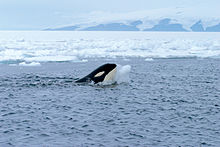Intelligence edit

Killer whales have the second-largest brains of all marine mammals.[1] They are easily trained in captivity and are often described as intelligent animals,[2][3] although it is difficult to define what exactly what intelligence is, or how to measure it, in a species whose environment and survival strategies are very different from those of humans.[3] From people who have interacted closely with killer whales, there are numerous anecdotes demonstrating killer whales' curiosity, playfulness, and ability to solve problems.
For example, killer whales in Alaska have not only learned how to steal fish from longlines, but have overcome a variety of techniques designed to dissuade them from the practice, such as the use of unbaited lines as decoys. Once, fishermen tried working together by placing their boats several miles apart and taking turns to retrieve small amounts of their catch, in the hope that killer whales would dash between boats not have enough time to steal any fish as it was being retrieved. A researcher described what happened next:
"It worked really well for a while. Then the whales split into two groups. It didn't even take them an hour to figure it out. They were so thrilled when they figured out what was going on, that we were playing games. They were breaching by the boats."
— Craig Matkin[4]
In other anecdotes, researchers describe incidents in which wild killer whales playfully tease humans by repeatedly moving objects that the humans are trying to reach,[5] or suddenly start to toss around a chunk of ice after a human throws a snowball.[6]
The killer whale's use of dialects and the passing of other learned behaviors from generation to generation have been described as forms of culture.[7] The paper Culture in Whales and Dolphins goes as far as to say, "The complex and stable vocal and behavioral cultures of sympatric groups of killer whales (Orcinus orca) appear to have no parallel outside humans and represent an independent evolution of cultural faculties."[8]
Moby Doll edit
Moby Doll was initially identified as female, until a visitor saw the whale having an erection.
- ^ Spear, Kevin. How smart are killer whales – and can they decide to kill a person? Orlando Sentinel, March 7, 2010. Retrieved on March 7, 2010.
- ^ Cite error: The named reference
cbs2010was invoked but never defined (see the help page). - ^ a b Carwardine, p. 67
- ^ Obee and Ellis, p. 42
- ^ "Springer continues to thrive" (PDF). Blackfish Sounder. 13. 2005. Retrieved 2007-11-04.
{{cite journal}}: Cite has empty unknown parameters:|month=and|coauthors=(help) - ^ Pitman, Robert L. Scientist Has 'Snowball Fight' With a Killer Whale. Live Science, February 6, 2009. Retrieved on March 7, 2010.
- ^ Marino, Lori et al. Cetaceans Have Complex Brains for Complex Cognition PLoS Biol. 2007 May; 5(5): e139. Retrieved on March 7, 2010.
- ^ Rendell, Luke, and Hal Whitehead. BBS Behavioral and Brain Sciences (2001), 24 : 309-324 Cambridge University Press. Retrieved on March 7, 2010.